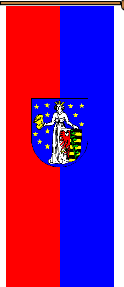- HABITED (or HABILLÉ)
- A heraldic term used to describe the customary clothing (the "habit") of a
monk or friar – habillé – but see
‘vested’ (also
‘clad’).
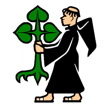

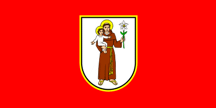

Flag of Münchenwiler, Switzerland (fotw);
Arms of Reith bei Kitzbühel, Austria (ICH);
Flag and Arms of Antunovac, Croatia (fotw)
- HAFTED (or HAFT)
- The heraldic term used when the handle of a hammer or an axe/mace (or of a similar tool/weapon) is of a different
tincture to its head – but see ‘hilted’ (also
‘barbed’,
‘garnished’,
‘shafted’ and
‘tincture’).
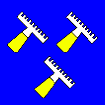
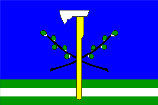



Flag of Curtilles, Switzerland (fotw); Flag of
Lhota u Vsetína, Czech Republic (fotw); Arms of
Alkoven, Austria (ICH); Flag and Arms of Jordanów,
Poland (fotw)
- HALBRUNDSCHILD
- The German term for a round-bottomed shield - see 'Spanish-style shield'.

- HALF MAST (or HALF STAFF) A FLAG
- (v & adj) To fly a flag at a point below its normal position, with the upper edge
of the flag about a third of the length of the flag pole, or at least a flag’s width,
from the truck, as a sign of mourning (see also
‘dip, at the’,
‘draping’,
‘flag pole’,
‘full mast’,
‘length’ and
‘truck’).
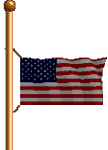
National Flag of the US at Half Mast (google.com)
Please note that a flag should, if the proper
procedure is followed, be first raised right up to the truck before being
lowered to its half-mast position, and raised once again to the truck before
being lowered completely.
- HALF MOON
- A term sometimes (inaccurately) used in place of crescent – see ‘crescent 1)’.
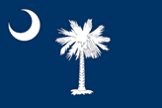
Flag of South Carolina, US (fotw)
- HALO
- See ‘nimbus’
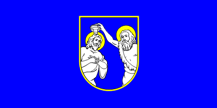

Flag and Arms of Koprivničko-Ivanec, Croatia (Željko Heimer)
- HALYARD
- A length of thin rope or cable by means of which flags might be hoisted and
lowered on a flag pole, mast or yardarm (see also ‘Appendix I’,
‘flag pole’,
‘mast’
and ‘yardarm’).
- HAMBURGIAN CORONET
- A specific form of the mural crown and related directly to the city of Hamburg, Germany –
see ‘mural crown 1)’
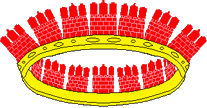
Klaus-Michael Schneider)
- HANDGUARD
- 1) In Spanish military usage and possibly some others, a metal guard fixed to the staff
of a military colour so as to protect the bearer’s right hand (originally in combat) – a
gardamano (see also ‘colour 2)’,
‘colours 2)’ and
‘staff 2)’).
2) See ‘saber’

A Handguard According to Spanish Regulations (Reglamento de Banderas Actualizado)
- HANDLED (or HANDLE)
- A term sometimes used to describe the hilt and pommel of a sword or dagger and the haft of a hammer,
axe or other tool – but see ‘hafted’ and ‘hilted’ (also
‘shafted’).

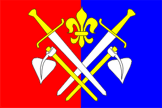
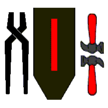
Arms and Flag of Drahenice, Czech Republic (fotw);
Flag of Harjedalen, Sweden (fotw)
- HANDSCHYNIE
- A Scottish term, now obsolete, for a miniature square banner.
- HANDSIGNE
- A 16th/17th Century variant spelling, now obsolete, of ensign – see
‘ensign 1)’
and ‘ensign 4)’ (also
'ancient 2)').
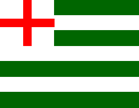
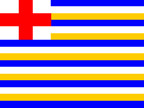
Handsigne/Ensign, English c1590 (fotw); Handsigne/Ensign,
English c1620 (fotw)
- HANDWAVER (or HANDFLAG)
- A small flag, usually made of either fabric or paper, fitted to a short stick and
intended to be waved by hand (see also ‘flaglet’ and
‘table flag’).
- HANGING FLAG
- A long vertically orientated flag - originally of Germanic origin and now
characteristic of both German speaking and other Central European countries – a vertical flag -
it is square-ended or swallow tailed, usually consists of the main flag charge
and livery colours (with its first or main colour next to the head of the
pole) and is specifically designed to be hung by its top edge from a
horizontal pole attached to a building - not to be confused with the banner as
defined herein and the similar (but usually shorter and more elaborately
designed) gonfalon (see also ‘banner 2)’,
‘bannerhead’,
‘flag charge’,
‘gonfalon 1)’,
‘inner edge’,
‘livery colours’,
‘outer edge’,
‘outrigger flag’,
‘rotated’
and ‘vertically hoisted flag
1)’).
The Flag and Hanging Flag of Cozwig/Anhalt, Germany (Jorg Majewski)
Please note, the Editors have adopted strict German vexillological
practice in that they have drawn a precisely defined distinction between a hanging flag and a
banner, with such differences lying in both the method of suspension and in the orientation of
the stripes, please note also however, that this may not necessarily apply in all cases.
- HANSEATENKREUZ
- See ‘Hanseatic cross’.
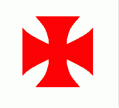
House Flag of G.H. Wappäus c1840, Hamburg (fotw)
- HANSEATIC CROSS (or HANSA CROSS)
- The term – and a direct translation of the German Hanseatenkreuz - for a war
war service medal issued by the former Hanseatic cities of Hamburg,
Lübeck and Bremen from 1915 - 1918, and which is sometimes used to describe a red, cross pattée
of Germanic, particularly (but not exclusively) Hanseatic origin – see
‘cross pattée’ in ‘appendix VIII’ (also
‘cross 2)’ and
‘iron cross’).
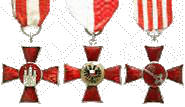
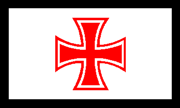

From left: The Hanseatic Crosses of Hamburg, Lübeck and Bremen (Hanseatic Cities),
Flag of the German Society for Rescuing the Shipwrecked (fotw), The Arms of Vegesack, Bremen, Germany (CS)
Notes
a) The above terms should only be used when the cross pattée
being described is red and/or is of a Hanseatic origin.
b)
Information suggests that this term (describing a cross as defined above) dates from the
early 19th century and the formation of volunteer corps from the former Hanseatic cities who took such a cross
as one of their emblems.
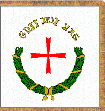
Flag of the Hamburg Citizen’s Militia 1814 – 1858 (Klaus-Michael Schneider)
- HARNYSED (or HARNESSED)
- The heraldic term used when a human figure is clad in armour – but see
‘vambraced’
(also ‘armoured’ and
‘armed 2)’.
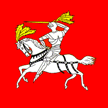

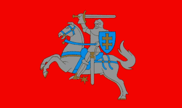

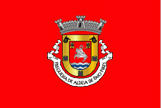
Flag of Collex-Bossy, Switzerland (fotw);
Arms of Šentjur pri Celju, Slovenia (fotw);
State Flag of Lithuania (fotw); Arms and Flag of Aldeia de Paio Pires, Portugal (Klaus-Michael Schneider)
- HATA-SASHIMONO
- See ‘daimyo flags’.
- HATCHING
- 1) In heraldry, a widely employed system of lines, dots and slashes used to indicate tinctures on a
monochrome illustration
– the Petra Santa method (see also ‘appendix III’ and ‘monochrome 1)’).
- 2) In vexillology, as 1) above but also used randomly to give a textural appearance to certain charges (see also
‘charge 1)’).

From left: Gules, Azure, Vert. Purpure, Sable, Or and Argent
Please note with regard to 1) that this method of depicting tinctures on a black and white
illustration was created in 1638, however, it is suggested that a glossary or dictionary of heraldry be consulted if
full details are required.
- HATCHMENT
- See ‘achievement 2)’.

Hatchment/Achievement of Arms of the Late Sir Winston Churchill, UK
(Churchill Society)
- HAURIENT
- See ‘appendix V’.
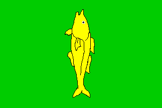
Flag of Figaró-Montmany, Spain (fotw)




















